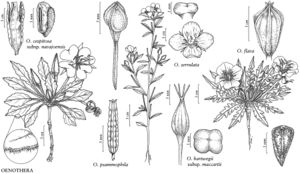Oenothera serrulata
Gen. N. Amer. Pl. 1: 246. 1818.
Herbs perennial, glabrous or strigillose; from a stout taproot. Stems 1–many, weakly decumbent to erect, unbranched to moderately branched, 10–60(–80) cm. Leaves 1–9 × 0.1–1 cm, sometimes fascicles of small leaves to 2 cm present in non-flowering axils; petiole 0–0.6 cm; blade linear to narrowly lanceolate or oblanceolate, often folded lengthwise, usually not much reduced distally, proximalmost stem leaves often narrowly oblanceolate to oblanceolate, sometimes spatulate, base attenuate, margins subentire or spinulose-serrate, apex acute. Flowers opening near sunrise; buds with free tips 0–4 mm; floral tube 2–12(–16) mm; sepals 1.5–9 mm, midribs keeled; petals yellow, fading dark yellow to orange, 5–12(–20) mm; antisepalous filaments 1–5(–7) mm, antipetalous filaments 0.5–3 mm, anthers 1.5–4(–6) mm, pollen 30–60(–80)% fertile; style 2–15(–20) mm, stigma discoid to quadrangular, surrounded by anthers at anthesis. Capsules 6–25 × 1–3 mm, hard, dehiscent 1/2 their length, often tardily dehiscent through their length. Seeds obovoid, 1–1.8 mm, sharply angled, apex truncate. 2n = 14.
Phenology: Flowering Mar–Aug.
Habitat: Prairies, in grassy, open areas in woods, rarely in mountains, usually sandy or rocky soil.
Elevation: 0–2100 m.
Distribution
Alta., Man., Ont., Sask., Ariz., Colo., Ill., Ind., Iowa, Kans., Mich., Minn., Mo., Mont., Nebr., N.Mex., N.Dak., Okla., S.Dak., Tex., Wis., Wyo., Mexico (Chihuahua).
Discussion
Oenothera serrulata occurs from southern Alberta, southern Saskatchewan, and southern Manitoba to eastern New Mexico, the Texas Panhandle, and the Gulf Coast of Texas, including eastern Montana, eastern Wyoming, eastern Colorado, North Dakota, South Dakota, Nebraska, Kansas, western and central Oklahoma, western and southern Minnesota, Iowa, northwestern Missouri, and with outlying populations in central Illinois, northern Indiana, southeastern Wisconsin, northwestern peninsular Michigan, east-central Arizona, and west-central Chihuahua, Mexico; it is naturalized in Ontario. It was documented in 1909 as a non-native in Vermont and has not been collected since. Oenothera serrulata is a PTH species and forms a ring of 12 + 1II or a ring of 14 chromosomes in meiosis, and is self-compatible and autogamous (H. F. Towner 1977).
Calylophus nuttallii Spach is a superfluous name that pertains here. Oenothera spachiana Steudel August 1840 (not Torrey & A. Gray June 1840) is an illegitimate later homonym and also pertains here.
H. F. Towner (1977) is followed here in recognition of a broadly delimited Oenothera serrulata as a complex assemblage of populations that are all primarily autogamous and are PTH. These populations consist of wide morphological diversity involving leaf size and shape, stature, pubescence, and flower size. Some of these variants may have evolved independently from O. capillifolia. Flower size is variable throughout the geographical range, and some of the largest flowered forms occur near large-flowered populations of O. capillifolia subsp. capillifolia in central Oklahoma. Most populations occurring west of approximately 98°W longitude comprise well-branched, short-leaved, and relatively low-statured plants, while those east of that line are less branched, taller and more erect, long-leaved, and densely strigillose. Populations along the Texas Gulf Coast described as Calylophus australis are rather distinctive and are separated from the remainder of the populations of O. serrulata primarily in less dense pubescence, shorter, coarsely serrate leaves, and more erect stems. They may have been independently derived from O. capillifolia. In his revision, Towner did not continue to recognize them because there were no data available on the phylogeny of other populations of O. serrulata. Subsequent detailed analyses (B. Cooper, unpubl.) indicate that the Texas coastal populations described as C. australis arose independently from other populations of O. serrulata, but O. serrulata also has multiple apparent origins from O. capillifolia.
Selected References
None.
